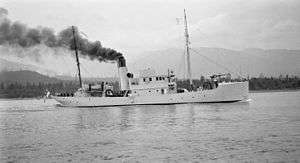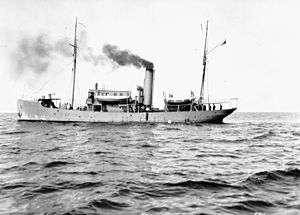Battle-class trawler
The Battle-class trawlers were a class of naval trawlers built for and used by the Royal Canadian Navy (RCN) during the First World War. Between the wars, some remained in RCN service, but most were transferred to the Department of Marine and Fisheries, where they performed a number of functions, including working as lightships and fisheries patrol vessels. During the Second World War, a number of these trawlers were re-acquired by the RCN, but all the navy's Battle-class trawlers were decommissioned soon after the war. A number of the class remained in civilian government and commercial service for years after the war, although most had been disposed of by the early 1960s.
 Armentières at Vancouver on 27 May 1933 | |
| Class overview | |
|---|---|
| Name: | Battle class |
| Builders: |
|
| Operators: |
|
| Built: | 1917 |
| In commission: | 1917–1946 |
| Completed: | 12 |
| Lost: | 4 |
| Scrapped: | 8 |
| General characteristics | |
| Type: | Naval trawler |
| Displacement: |
|
| Length: | 130 ft (40 m) |
| Beam: |
|
| Draught: |
|
| Propulsion: | 1 x triple expansion, 480 ihp (360 kW) |
| Speed: | 10 knots (12 mph; 19 km/h) |
| Armament: | 1 × QF 12 pounder 12 cwt naval gun |
Design and description
The RCN's Battle-class trawlers formed part of the Canadian naval response to Admiralty warnings to Canada about the growing German U-boat threat to merchant shipping in the western Atlantic.[1] Intended to augment anti-submarine patrols off Canada's east coast, these ships were modelled on contemporary British North Sea trawlers, since the standard types of Canadian fishing vessels were considered unsuitable for patrol work.[2]
Twelve vessels were ordered on 2 February 1917 from two shipyards, Polson Iron Works of Toronto and Canadian Vickers of Montreal.[3] Those vessels built at Polson Iron Works displaced 320 long tons (330 t) and were 130 feet (40 m) long overall with a beam of 23 feet 5 inches (7.14 m) and a draught of 13 feet 5 inches (4.09 m).[4] Those trawlers ordered from Canadian Vickers displaced 357 long tons (363 t), with the same length, a beam of 25 feet (7.6 m) and a draught of 13 feet (4.0 m).[4] The vessels were propelled by a steam-powered triple expansion engine driving one shaft creating 480 indicated horsepower (360 kW) giving the vessels a maximum speed of 10 knots (19 km/h; 12 mph).[3][5]
All twelve trawlers were equipped with a QF 12-pounder 12 cwt naval gun mounted forward.[4][lower-alpha 1] This was considered to be the smallest gun that stood a chance of putting a surfaced U-boat out of action, and they also carried a small number of depth charges.[1][6] The trawlers were named after battles of the Western Front during the First World War that Canadians had been involved in. They cost between $155,000 and $160,000 per vessel.[3][lower-alpha 2][lower-alpha 3]
Construction and service
Of the twelve trawlers, six contracts were awarded to Polson and six to Canadian Vickers.[3] Of the six awarded to Canadian Vickers, two were allotted to Kingston Shipbuilding in Kingston, Ontario.[7] Intended for use during the 1917 shipping season, the construction of the vessels was delayed by the entry of the United States into the war. With higher wages found south of the border, a shortage of skilled labour developed in the shipyards, coupled with a shortage of construction material.[8]
The six trawlers constructed by Polson were all launched in June 1917, but were handed over to the Royal Canadian Navy until the fall.[3][9] The six vessels built by Polson, Vimy, Ypres, St. Julien, Messines, Festubert, and St. Eloi, were commissioned on 13 November 1917.[7] The six vessels ordered from Canadian Vickers were delayed further by difficulty in providing engines for the trawlers. The hulls had been finished during Summer 1917. However, the engines did not arrive until the fall. The first two, Arleux and Armentières, commissioned on 5 June 1918 and the remaining four, Loos, Thiepval, Givenchy and Arras, were commissioned on 1 August 1918.[7]
For the defence of shipping in Canadian waters in 1918, the entire Battle class was assigned to work out of Sydney, Nova Scotia.[10] Following the sinking of the merchant vessel Luz Blanca off Halifax, Nova Scotia, Armentières, St. Eloi and Festubert were tasked with hunting for the German submarine U-156, which had been operating off the coast of Nova Scotia.[11] The rest of the Battle class was used for patrol and escort duties.[12] One of the class was assigned to the Gulf Escort Force, escorting vessels through the Gulf of St. Lawrence.[13]
Interwar period

The twelve trawlers remained in commission with the RCN until 1920, and in early 1919, three of them (Armentières, Givenchy, and Thiepval) accompanied Stadacona on a trip to the west coast via the Panama Canal. In 1920, nine of the class were transferred to the Department of Marine and Fisheries, where they served as buoy tenders, fisheries patrol vessels, and lightships, although one of the ships (Armentières) was soon returned to the RCN. Loos became a buoy tender, while Arleux, Arras, and Givenchy became fisheries patrol vessels. Messines, St. Eloi, St. Julien, and Vimy were converted to lightships. They remained in service with the Department of Marine and Fisheries throughout the interwar period, but a number were re-acquired by the RCN on the eve of the Second World War and returned to naval service.[14]
Two of the class (Festubert and Ypres) were not transferred to civilian government service, and were rejoined by Armentières and Thiepval in 1923.[15] In 1922, the Battle class were redesignated minesweepers.[16] Remaining with the RCN throughout this time, they served as patrol and training vessels, and some were placed in reserve at various points.[9] Festubert and Ypres operated on the east coast while Armentières and Thiepval operated on the west coast.[17] In 1924, Thiepval undertook a lengthy trip across the North Pacific to the Soviet Union and Japan to support an ultimately unsuccessful British round-the-world flight attempt.[18] On 2 September 1925 Armentières was sunk in Pipestem Inlet, British Columbia. The trawler was refloated and recommissioned in 1926.[4] Thiepval struck an uncharted rock in the Broken Islands of Barkley Sound on British Columbia's west coast, and sank.[19]
Second World War and fate

By 1939, only one Battle-class trawler, Armentières, remained in active naval service, although Festubert was in reserve and Ypres had just emerged from a refit to become a gate vessel for Halifax's anti-submarine defences. During 1939, the RCN re-acquired five other members of the class: Arleux, Arras, Loos, and St. Eloi on the east coast, and Givenchy on the west coast. The east coast trawlers served primarily as gate vessels at Nova Scotia ports including Halifax and Sydney. In 1940, the British battleship HMS Revenge accidentally rammed and sank Ypres, but without loss of life. On the west coast, Armentières served as an examination vessel, while Givenchy served primarily as an accommodation ship.[9]
Following the Second World War, the trawlers that had served with the RCN were soon decommissioned and either sold or returned to civilian government service. Many were broken up in the 1950s or otherwise disposed of in the early 1960s, although two (Armentières and St. Julien) were still in existence in the 1970s, and their final fates remain unclear.[9]
Ships in class
| Battle-class trawlers[9] | ||||||
|---|---|---|---|---|---|---|
| Name | Builder | Launched | Commissioned | Decommissioned | Recommissioned | Fate |
| Arleux | Canadian Vickers, Montreal | 9 August 1917 | 5 June 1918 | 30 June 1922 | 13 September 1939 | Sold for commercial use in 1946, foundered 1948 |
| Armentières | Canadian Vickers, Montreal | 11 August 1917 | 5 June 1918 | 28 October 1919 | 1923 | Sold for commercial use in 1946 |
| Arras | Canadian Vickers, Montreal | 15 September 1917 | 8 July 1918[lower-alpha 4] | 1919 | 11 September 1939 | Sold for scrap and broken up 1957 |
| Festubert | Polson Iron Works, Toronto | 2 August 1917 | 13 November 1917 | 1 May 1923 | Scuttled 1971 | |
| Givenchy | Canadian Vickers, Montreal | 15 September 1917 | 22 June 1918[lower-alpha 4] | 12 August 1919 | 25 June 1940 | Broken up 1953 |
| Loos | Kingston Shipbuilding, Kingston | 27 September 1917 | 1 August 1918 | 1920 | 12 December 1940 | Sold 1945, broken up 1949 |
| Messines | Polson Iron Works, Toronto | 16 June 1917 | 13 November 1917 | 1920 | N/A | Converted to lightship Lightship No. 3, broken up 1962 |
| St. Eloi | Polson Iron Works, Toronto | 2 August 1917 | 13 November 1917 | 1920 | 1940 | Discarded 1962 |
| St. Julien | Polson Iron Works, Toronto | 16 June 1917 | 13 November 1917 | 1920 | N/A | Transferred to Department of Marine and Fisheries and converted to lightship Lightship No. 22 |
| Thiepval | Kingston Shipbuilding, Kingston | 1917 | 24 July 1918[lower-alpha 4] | 19 March 1920 | 1 April 1923 | Sunk 27 February 1930 |
| Vimy | Polson Iron Works, Toronto | 16 June 1917 | 13 November 1917 | 30 November 1918 | N/A | Transferred to Department of Marine and Fisheries, converted to lightvessel Lightship No. 5, 1922 |
| Ypres | Polson Iron Works, Toronto | 16 June 1917 | 13 November 1917 | 1920 | 1 May 1923 | Sunk 12 May 1940 |
References
Notes
- "Cwt" is the abbreviation for hundredweight, 20 cwt referring to the weight of the gun.
- Adjusted for inflation to 2020 dollars, $2,323,258 to $2,398,202
- Tucker places the cost at $191,000 (adjusted for inflation to 2020 dollars, $2,862,854)[6]
- Johnston et al. claim the ship was commissioned on 1 August 1918.
Citations
- Tucker, p. 253
- Tucker, pp. 254, 257
- Johnston et al., p. 417
- Macpherson and Barrie, p. 27
- Maginley and Collin, p. 67
- Tucker, p. 257
- Johnston et al., p. 484
- Johnston et al., pp. 481–484
- Macpherson and Barrie, pp. 27–31
- Johnston et al., p. 543
- Johnston et al., pp. 635, 643–644, 665
- Johnston et al., p. 645
- Johnston et al., p. 657
- Maginley and Collin, p. 113
- Macpherson and Barrie, pp. 27–28, 31
- Johnston et al., p. 801
- Johnston et al., p. 891
- Johnston et al., pp. 832–837
- Johnston et al., p. 892
Sources
- Johnston, William; Rawling, William G.P.; Gimblett, Richard H. & MacFarlane, John (2010). The Seabound Coast: The Official History of the Royal Canadian Navy, 1867–1939. 1. Toronto: Dundurn Press. ISBN 978-1-55488-908-2.
- Macpherson, Ken & Barrie, Ron (2002). The Ships of Canada's Naval Forces 1910–2002 (Third ed.). St. Catharines, Ontario: Vanwell Publishing. ISBN 1-55125-072-1.
- Maginley, Charles D. & Collin, Bernard (2001). The Ships of Canada's Marine Service. St. Catharines, Ontario: Vanwell Publishing Limited. ISBN 1-55125-070-5.
- Tucker, Gilbert Norman (1962). The Naval Service of Canada, Its Official History – Volume 1: Origins and Early Years. Ottawa: King's Printer. OCLC 840569671.